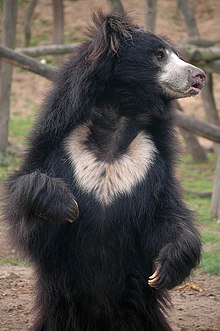| Sloth bear Temporal range: Late Pliocene to Early Pleistocene – recent
| |
|---|---|

| |
| Standing Melursus ursinus | |
| Scientific classification | |
| Domain: | Eukaryota |
| Kingdom: | Animalia |
| Phylum: | Chordata |
| Class: | Mammalia |
| Order: | Carnivora |
| Family: | Ursidae |
| Subfamily: | Ursinae |
| Genus: | Melursus Meyer, 1793 |
| Species: | M. ursinus
|
| Binomial name | |
| Melursus ursinus (Shaw, 1791)
| |

| |
| Sloth bear range (black – former, green – extant) | |
| Synonyms | |
The sloth bear (Melursus ursinus), also known as the Indian bear, is a myrmecophagous bear species native to the Indian subcontinent. It feeds on fruits, ants and termites. It is listed as vulnerable on the IUCN Red List, mainly because of habitat loss and degradation.[1] It is the only species in the genus Melursus.
It has also been called "labiated bear" because of its long lower lip and palate used for sucking up insects.[2] It has long, shaggy fur, a mane around the face, and long, sickle-shaped claws. It is lankier than brown and Asian black bears. It shares features of insectivorous mammals and evolved during the Pleistocene from the ancestral brown bear through divergent evolution.
Sloth bears breed during spring and early summer and give birth near the beginning of winter. When their territories are encroached upon by humans, they sometimes attack them. Historically, humans have drastically reduced these bears' habitat and diminished their population by hunting them for food and products such as their bacula and claws. Sloth bears have been tamed and used as performing animals and as pets.[3]
- ^ a b c Dharaiya, N.; Bargali, H. S. & Sharp, T. (2020) [amended version of 2016 assessment]. "Melursus ursinus". IUCN Red List of Threatened Species. 2020: e.T13143A166519315. doi:10.2305/IUCN.UK.2020-1.RLTS.T13143A166519315.en. Retrieved 16 January 2022.
- ^ Cite error: The named reference
elliottwas invoked but never defined (see the help page). - ^ Servheen
